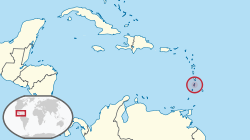| Boa orophias | |
|---|---|
 | |
| Scientific classification | |
| Kingdom: | Animalia |
| Phylum: | Chordata |
| Class: | Reptilia |
| Order: | Squamata |
| Suborder: | Serpentes |
| Family: | Boidae |
| Genus: | Boa |
| Species: | B. orophias |
| Binomial name | |
| Boa orophias | |
 | |
| Location of Saint Lucia | |
Boa orophias, the Saint Lucia boa or San Lucia boa, is a species of snake in the family Boidae. The species is endemic to Saint Lucia. Boa orophias was described as a full species by Carl Linnaeus in 1758, but many later authors have classified it as a subspecies of Boa constrictor . [3] According to the IUCN Red List, Boa orophias is a species, which they have listed as Endangered. It eats small mammals and birds. [1]
